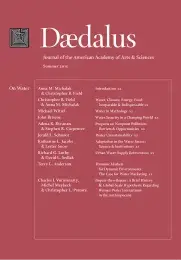Urban Water-Supply Reinvention
Cities in drought-prone regions of the American West and Australia provide examples of innovative approaches to utilizing local water resources to achieve more resilient water supplies. Geographical realities, population growth, and favorable economic conditions can create the impetus for investments in new technologies, while support by activist groups and NGOs can encourage more sustainable approaches using locally sourced water. New approaches–whether desalination, stormwater use, water recycling, or potable reuse–share a common path to mass adoption. After a period of piloting and demonstration-scale projects, water providers with few options become early adopters of new technologies. And after the early adopters have gained experience and have used it to support the new approaches, the costs and risks of failure decrease for other providers. Thus, a wider cross section can adopt the new approach. The pioneering projects described herein are the first stage of the reinvention of our urban water systems.
The solution to the challenge of urban water security will likely consist of a combination of demand management and the development of a portfolio of new water supplies. For reasons described in this essay–in addition to competing demands for imported water and the impacts of climate change on the hydrologic cycle–it is likely that new water supplies will rely on a mixture of localized strategies such as desalination, urban stormwater capture, and water recycling. To gain insight into the factors influencing the process through which cities pursue new forms of local water supply, and to identify policies that can be used to encourage the transition to more resilient urban water supplies, it is instructive to consider four specific technologies–desalination, stormwater use, water recycling, and potable water reuse–and the preconditions that have led cities to adopt different solutions. With respect to the development of urban water systems, local conditions play a major role in the decision-making process. Nonetheless, some common themes are evident among the early adopters of urban water-supply reinvention and water reuse. For example, rapid population growth coupled with favorable economic conditions can create an imperative for responding to water stress through investment in new water-supply technologies, rather than by imposing growth restrictions or expecting further gains once demand-management solutions are in place (such as mandates for specific types of landscaping or changes in plumbing codes). In addition, the concerns of activist groups and NGOs, the ability to develop alternative supplies (as opposed to limiting choices), local geographic constraints, and water quality concerns – particularly with respect to salt management–all play an important role in the selection of the specific technologies used in decisions about future water supplies.
Australia is the driest inhabited continent; and its population is concentrated in urban areas along the coast. Australia has experienced many droughts, but the most severe drought since British settlement was what came to be known as the millennium drought, which lasted from approximately 1997 to 2009. The millennium drought altered public opinion about climate change and water-use behavior, and energized governments to take swift action to “drought-proof” their water supplies.1 In what is described as one of the most dramatic and swiftest water infrastructure transitions ever undertaken,2 Australia’s five major metropolitan areas (Sydney, Melbourne, Brisbane, Perth, and Adelaide) embraced seawater desalination to augment drinking-water supplies and commenced on a rapid five-year infrastructure construction program.
. . .
